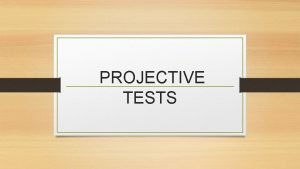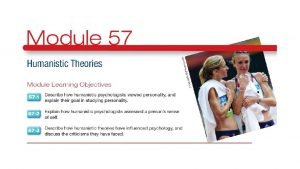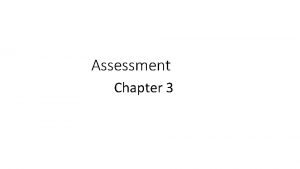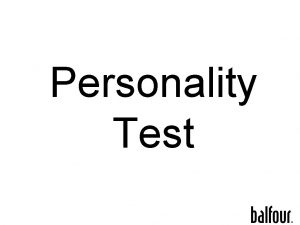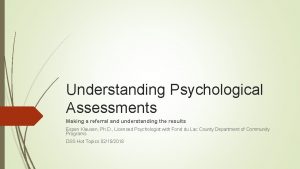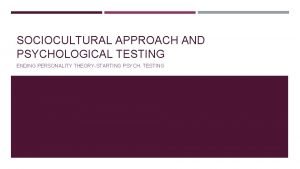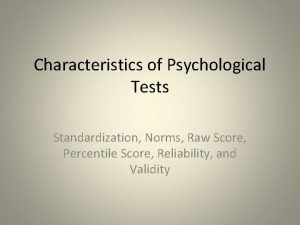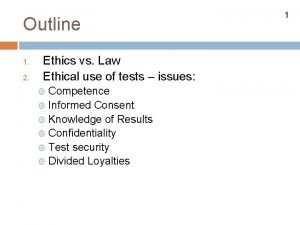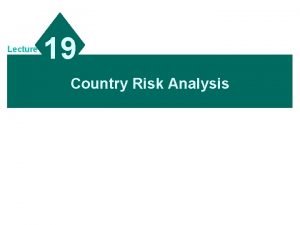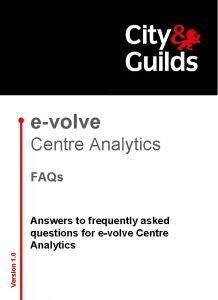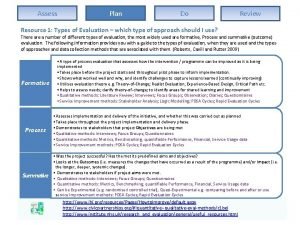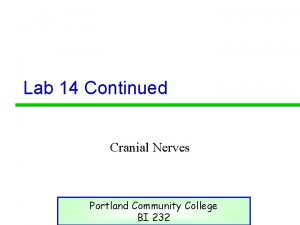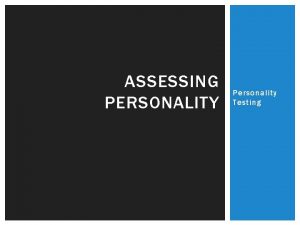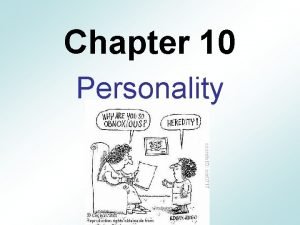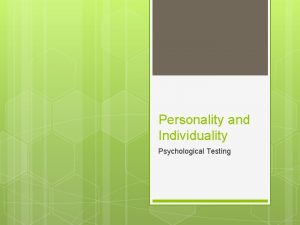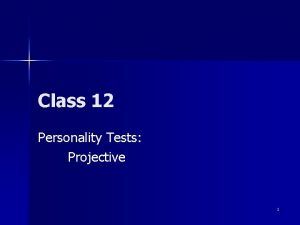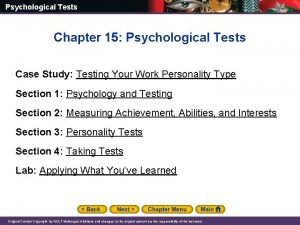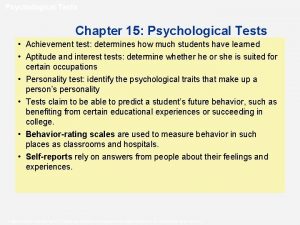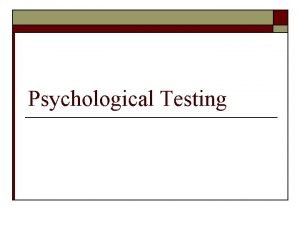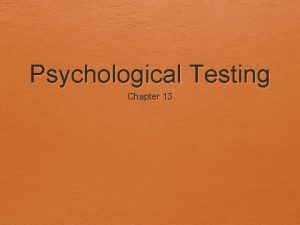Assessing Personality Testing Psychological Testing Psychological tests assess


















- Slides: 18

Assessing Personality Testing

Psychological Testing • Psychological tests assess a person’s abilities, aptitudes, interests or personality based on a systematically obtained sample of behavior. 2 Basic Goals 1. Accurately & consistently reflect a person’s characteristics on some dimension. 2. Predicts a person’s future psychological functioning or behavior.

Personality Assessment Projective Techniques • Interpretation of an ambiguous to trigger projection of one’s inner thoughts and feelings • Used to determine unconscious motives, conflicts, and psychological defenses & traits

Rorschach Inkblot Test • Presentation and interpretation of a series of black and white and colored inkblots • Developed in 1921. • Personality test that seeks to identify people’s inner feelings by analyzing their interpretations of 10 inkblots • Numerous scoring systems exist


Thematic Apperception Test • Series of pictures depicting ambiguous scenes • Subject is asked to create a story about the scene • Answers are scored based on themes, motives, and anxieties of main character


Drawbacks to Projective Tests • Examiner or test situation may influence individual’s response • Scoring is highly subjective • Tests fail to produce consistent results (reliability problem) • Tests are poor predictors of future behavior (validity problem)

Testing for Traits: Self-Report Inventories

Personality Inventories • Questionnaires on which people respond to items designed to gauge a wide range of feelings and behaviors • Used to assess selected personality traits • Often true-false, agree-disagree, etc. types of questions • Person’s responses to standardized questions are compared to established norms.

Validity • The extent to which a test measures or predicts what it is suppose to test • Personality inventories offer greater validity than do projective tests (e. g. Rorschach; used by proponents of the humanistic perspective).

Reliability • The extent to which a test yields consistent results, regardless of who gives the test or when or where it is given • Personality inventories are more reliable than projective tests.

MMPI • Minnesota Multiphasic Personality Inventory (MMPI) • Most clinically-used personality test • 500 total questions • Originally designed to assess abnormal behavior

MMPI Scoring Profile

MMPI-2 • Revised and updated version of the MMPI • Assesses test takers on 10 clinical scales and 15 content scales • Sometimes the MMPI-2 is not used as it was intended.

Other Self-Report Inventories • California Personality Inventory (CPI) – assesses personality characteristics in normal populations. • Sixteen Personality Factor Questionnaire (16 PF) – Cattell’s test that creates a personality profile on 16 trait dimensions.

Strengths of Self-Reports • Standardized—each person receives same instructions and responds to the same questions • Use of established norms: results are compared to previously established norms and are not subjectively evaluated • Greater reliability and validity than projective tests.

Weaknesses of Self-Reports • Evidence that people can “fake” responses to look better (or worse) • Some people are prone to responding in a set way, whether the item accurately reflects them or not. • Tests contain hundreds of items and become tedious • People may not be good judges of their own behavior
 Define projective test
Define projective test Humanistic psychologists may assess personality by
Humanistic psychologists may assess personality by Iq intelligence
Iq intelligence Unlike psychological tests, behavioral assessments record
Unlike psychological tests, behavioral assessments record The pig test
The pig test Personality dynamics, meaning
Personality dynamics, meaning Referral question psychological report sample
Referral question psychological report sample Psychological testing examples
Psychological testing examples Standardization of psychological test
Standardization of psychological test Neuropsychological testing examples
Neuropsychological testing examples Sfeedtest
Sfeedtest Hr planning process
Hr planning process Techniques to assess country risk
Techniques to assess country risk Evolve secureassess
Evolve secureassess How to assess alert and oriented
How to assess alert and oriented Assess plan do review model
Assess plan do review model Assess plan act
Assess plan act How to assess glossopharyngeal nerve
How to assess glossopharyngeal nerve Sqa solar open assess
Sqa solar open assess
